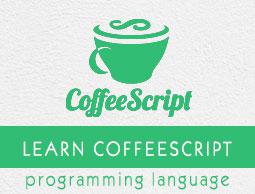CoffeeScript - Objects
Objects in CoffeeScript are similar to those in JavaScript. These are a collection of the properties, where a property includes a key and a value separated by a semi colon (:). In short, CoffeeScript objects are a collection of key-value pairs. The objects are defined using curly braces, an empty object is represented as {}.
Syntax
Given below is the syntax of an object in CoffeeScript. In here, we place the key-value pairs of the objects within the curly braces and they are separated using comma (,).
object ={key1: value, key2: value,......keyN: value}
Example
Following is an example of defining an object in CoffeeScript. Save this code in a file with name objects_example.coffee
student = {name: "Mohammed", age: 24, phone: 9848022338 }
Open the command prompt and compile the .coffee file as shown below.
> coffee -c objects_example.coffee
On compiling, it gives you the following JavaScript.
// Generated by CoffeeScript 1.10.0
(function() {
var student;
student = {
name: "Mohammed",
age: 24,
phone: 9848022338
};
}).call(this);
Just as in arrays, we can remove the commas by specifying the key-value pairs in new lines as shown below.
student = {
name: "Mohammed"
age: 24
phone: 9848022338
}
Indentations instead of curly braces
Just like other block statements in CoffeeScript, we can use indentations instead of curly braces {} as shown in the following example.
Example
We can rewrite the above example without curly braces as shown below.
student =
name: "Mohammed"
age: 24
phone: 9848022338
Nested objects
In CoffeeScript, we can write objects within objects.
Example
The following example demonstrates the nested objects in CoffeeScript. Save this code in a file with name nested_objects.coffee
contact =
personal:
email: "personal@gmail.com"
phone: 9848022338
professional:
email: "professional@gmail.com"
phone: 9848033228
Open the command prompt and compile the .coffee file as shown below.
> coffee -c nested_objects.coffee
On compiling, it gives you the following JavaScript.
// Generated by CoffeeScript 1.10.0
(function() {
var contact;
contact = {
personal: {
email: "personal@gmail.com",
phone: 9848022338
},
professional: {
email: "professional@gmail.com",
phone: 9848033228
}
};
}).call(this);
Comprehensions over objects
To iterate over the contents of an object, we can use comprehensions. Iterating the contents of an object is same as iterating the contents of an array. In objects, since we have to retrive two elements keys and values we will use two variables.
Example
The following is an example showing how to iterate the contents of an object using comprehensions. Save this code in a file with name object_comprehensions.coffee
student =
name: "Mohammed"
age: 24
phone: 9848022338
console.log key+"::"+value for key,value of student
Open the command prompt and compile the .coffee file as shown below.
> coffee -c object_comprehensions.coffee
On compiling, it gives you the following JavaScript.
// Generated by CoffeeScript 1.10.0
(function() {
var key, student, value;
student = {
name: "Mohammed",
age: 24,
phone: 9848022338
};
for (key in student) {
value = student[key];
console.log(key(+"::" + value));
}
}).call(this);
Now, open the command prompt again and run the CoffeeScript file as shown below.
> coffee object_comprehensions.coffee
On executing, the CoffeeScript file produces the following output.
name::Mohammed
age::24
phone::9848022338
Arrays of Objects
In CoffeeScript, an array can also contain objects in as shown below.
a = [
object1_key1: value
object1_key2: value
object1_key3: value
,
object2_key1: value
object2_key2: value
object2_key3: value
]
The following example shows how to define an array of objects. We can just list the key value pairs of the objects we want in an array by separating them using commas (,).
students =[
name: "Mohammed"
age: 24
phone: 9848022338
,
name: "Ram"
age: 25
phone: 9800000000
,
name: "Ram"
age: 25
phone: 9800000000
]
console.log student for student in students
Open the command prompt and compile the .coffee file as shown below.
c:\> coffee -c array_of_objects.coffee
On compiling, it gives you the following JavaScript.
// Generated by CoffeeScript 1.10.0
(function() {
var i, len, student, students;
students = [
{
name: "Mohammed",
age: 24,
phone: 9848022338
}, {
name: "Ram",
age: 25,
phone: 9800000000
}, {
name: "Ram",
age: 25,
phone: 9800000000
}
];
for (i = 0, len = students.length; i < len; i++) {
student = students[i];
console.log(student);
}
}).call(this);
Now, open the command prompt again and run the CoffeeScript file as shown below.
c:\> coffee array_of_objects.coffee
On executing, the CoffeeScript file produces the following output.
{ name: 'Mohammed', age: 24, phone: 9848022338 }
{ name: 'Ram', age: 25, phone: 9800000000 }
{ name: 'Ram', age: 25, phone: 9800000000 }
Reserved Keywords
JavaScript does not allow reserved keywords as property names of an object, if we want use them, we have to wrap them using double quotes " ".
Example
Consider the following example. Here we have created a property with name class, which is a reserved keyword. Save this code in a file with name reserved_keywords.coffee
student ={
name: "Mohammed"
age: 24
phone: 9848022338
class: "X"
}
console.log key+"::"+value for key,value of student
Open the command prompt and compile the .coffee file as shown below.
c:\> coffee -c reserved_keywords.coffee
On compiling, it gives you the following JavaScript. Here you can observe that the CoffeeScript compiler wrapped the keyword class with double quotes on behalf of us.
// Generated by CoffeeScript 1.10.0
(function() {
var key, student, value;
student = {
name: "Mohammed",
age: 24,
phone: 9848022338,
"class": "X"
};
for (key in student) {
value = student[key];
console.log(key + "::" + value);
}
}).call(this);
Now, open the command prompt again and run the CoffeeScript file as shown below.
c:\> coffee array_of_objects.coffee
On executing, the CoffeeScript file produces the following output.
name::Mohammed
age::24
phone::9848022338
class::X


